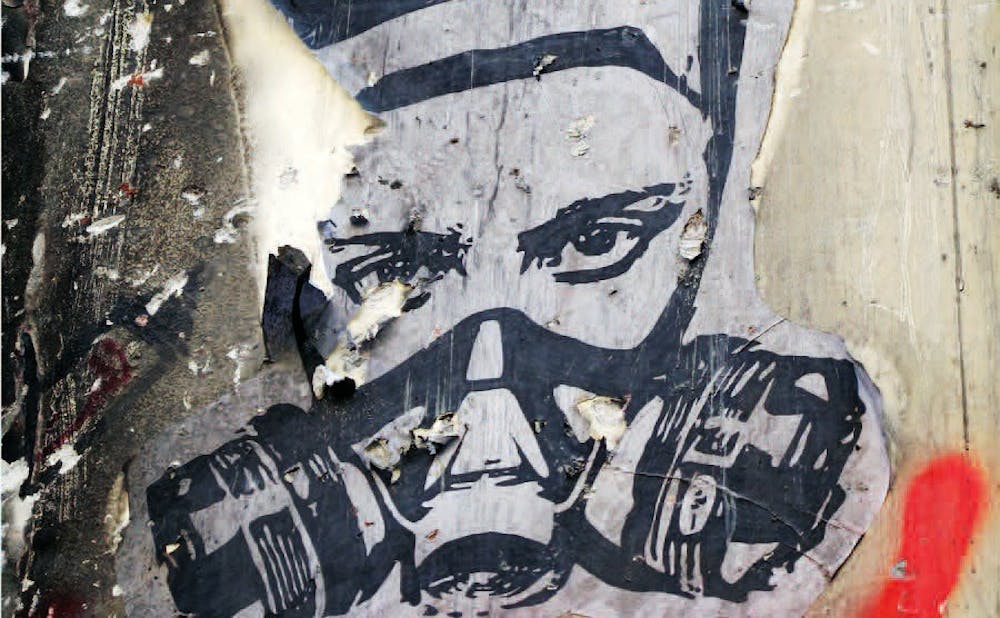Between September 16 and November 22, Gröndahl’s photographs of this graffiti will be on display in an exhibit at the John Hope Franklin Center. The opening reception will be on September 17 between 5:00 and 6:30 p.m.
“I think it will be really fabulous,” gushed miriam cooke, Professor of Asian and Middle Eastern Studies and an organizer of the exhibit. In addition to Gröndahl herself being present to talk and answer questions, the entire area will be “wallpapered,” according to cooke, with various photos of the graffiti. In fact, the exhibit is set up to feel like a street in Cairo.
“I believe very strongly that creative artists and writers have a vision that we [as scholars] don’t,” explained cooke. The intent is to open the doors for a wider conversation. By allowing students, faculty and community members to engage with the artists, everyone can gain new perspectives. Displaying what cooke describes as “what it is that [the graffiti artists] are envisioning the next steps to be” allows for interaction between the scholarly community that thrives on campus and the artists that are inspiring and shaping the revolutions in the Middle East.
It's important to see the “ways in which artists, cartoonists, graphic artists, plastic artists, writers, filmmakers and musicians have participated in various revolutions around the Arab world,” cooke said. People watched hopefully as Cairo and Tunisia fell with very little violence, a surprising and exciting event. But, soon enough, the violence picked up, and people went back to seeing only the stereotypical. “We aren’t thinking about the human part—the humanity of the revolutionaries,” cooke said. She is hoping that, by giving exposure to this kind of art, graffiti wars can begin to take the place of lethal wars.
“Out of cracks in these governments grew this beautiful cultural production that was not just artwork. It was music and street theater and slogans and chants and poetry,” says Ellen McLarney, Assistant Professor of Arabic Literature and Culture and another organizer of the events. “Cultural production became a vehicle for political mobilization.” This explosion of media and culture after and during the revolutions of the Middle East helped to express “a hope for a new Egypt, a new Tunisia, a new Nigeria,” explained McLarney. By providing a window into what is happening, this artwork allows viewers to see the perspective of all those present at the Egyptian Revolution.
In addition to the exhibit, Gröndahl is speaking on Wednesday, September 18 as part of the ongoing series, “Wednesdays at The Center.” She will be giving a one-hour talk about the experience of photographing graffiti, both in Cairo and other places of conflict, like the Gaza Strip.
Despite the many topics addressed by this exhibit, “Revolution Graffiti” is merely one piece of a much larger project. “There is a broader conversation on campus. This is just one highlighted segment,” explained Kelly Jarret, Associate Director of the Duke Islamic Studies Center and the Duke Middle East Studies Center. This is all part of "Arts of Revolution," a year-long series. While many of the events will concern the Middle East, there will also be talks on a wide variety of global issues, including topics like “Jews and Muslims in the Americas,” which will be an interdepartmental collaboration. A rap artist from Tunisia will be coming in the spring, and a conference involving writers, artists and scholars, will occur at the end of March.
It is clear that the Middle East is in turmoil right now. There are deaths nearly every day, and debates rage over the proper course of action for the international community to take. But sometimes, it is not the political leaders and hardliner generals that we should pay attention to. Sometimes, we need to look to the people—the community—to see the real situation. Sometimes, the world needs to look to the artists.
"Revolution Graffiti: Street Art of Egypt" opens September 16 at the John Hope Franklin Center. The opening reception is September 17 at 5 p.m. Gröndahl’s lecture will be September 18 at noon. For more information, visit this website.
Get The Chronicle straight to your inbox
Signup for our weekly newsletter. Cancel at any time.

